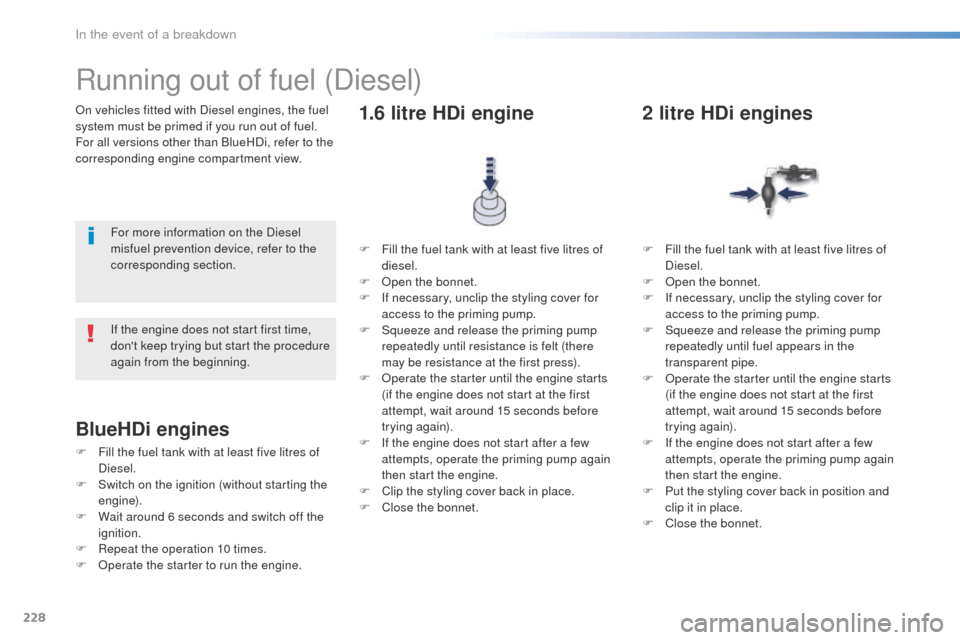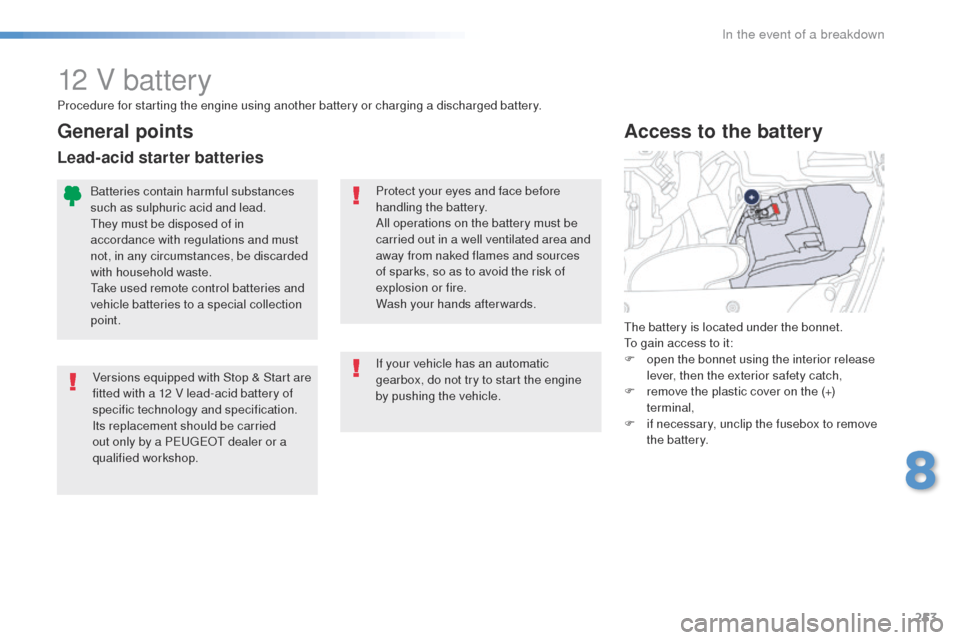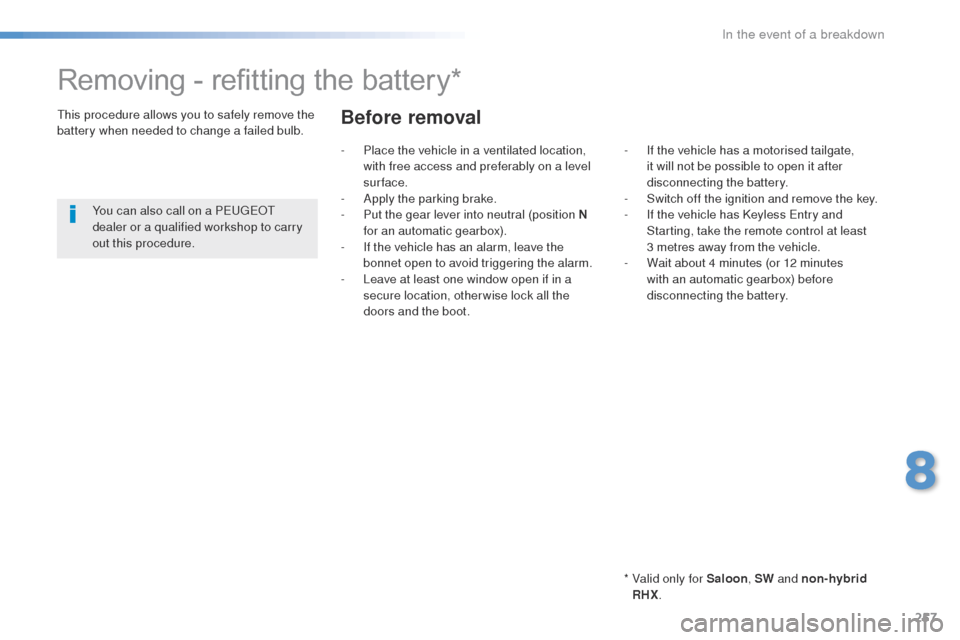Page 230 of 364

228
508_en_Chap08_en-cas-de-pannes_ed01-2016
On vehicles fitted with Diesel engines, the fuel
system must be primed if you run out of fuel.
For all versions other than BlueHDi, refer to the
corresponding engine compartment view.
Running out of fuel (Diesel)
For more information on the Diesel
misfuel prevention device, refer to the
corresponding section.F
F
ill the fuel tank with at least five litres of
diesel.
F
O
pen the bonnet.
F
I
f necessary, unclip the styling cover for
access to the priming pump.
F
S
queeze and release the priming pump
repeatedly until resistance is felt (there
may be resistance at the first press).
F
O
perate the starter until the engine starts
(if the engine does not start at the first
attempt, wait around 15 seconds before
trying again).
F
I
f the engine does not start after a few
attempts, operate the priming pump again
then start the engine.
F
C
lip the styling cover back in place.
F
C
lose the bonnet.
1.6 litre HDi engine
F Fill the fuel tank with at least five litres of Diesel.
F
O
pen the bonnet.
F
I
f necessary, unclip the styling cover for
access to the priming pump.
F
S
queeze and release the priming pump
repeatedly until fuel appears in the
transparent pipe.
F
O
perate the starter until the engine starts
(if the engine does not start at the first
attempt, wait around 15 seconds before
trying again).
F
I
f the engine does not start after a few
attempts, operate the priming pump again
then start the engine.
F
P
ut the styling cover back in position and
clip it in place.
F
C
lose the bonnet.
2 litre HDi engines
If the engine does not start first time,
don't keep trying but start the procedure
again from the beginning.
BlueHDi engines
F Fill the fuel tank with at least five litres of Diesel.
F
S
witch on the ignition (without starting the
engine).
F
W
ait around 6 seconds and switch off the
ignition.
F
R
epeat the operation 10 times.
F
O
perate the starter to run the engine.
In the event of a breakdown
Page 255 of 364

253
508_en_Chap08_en-cas-de-pannes_ed01-2016
12 V battery
Versions equipped with Stop & Start are
fitted with a 12 V lead-acid battery of
specific technology and specification.
Its replacement should be carried
out only by a P
e
uge
Ot
dealer or a
qualified workshop.
th
e battery is located under the bonnet.
to g
ain access to it:
F
o
pen the bonnet using the interior release
lever, then the exterior safety catch,
F r emove the plastic cover on the (+)
terminal,
F
i
f necessary, unclip the fusebox to remove
the battery.
Access to the battery
Procedure for starting the engine using another battery or charging a discharged battery.
Protect your eyes and face before
handling the battery.
All operations on the battery must be
carried out in a well ventilated area and
away from naked flames and sources
of sparks, so as to avoid the risk of
explosion or fire.
Wash your hands afterwards.
Batteries contain harmful substances
such as sulphuric acid and lead.
th
ey must be disposed of in
accordance with regulations and must
not, in any circumstances, be discarded
with household waste.
ta
ke used remote control batteries and
vehicle batteries to a special collection
point.
General points
Lead-acid starter batteries
If your vehicle has an automatic
gearbox, do not try to start the engine
by pushing the vehicle.
8
In the event of a breakdown
Page 259 of 364

257
508_en_Chap08_en-cas-de-pannes_ed01-2016
Removing - refitting the battery*
* Valid only for Saloon, SW and non-hybrid
RHX.
th
is procedure allows you to safely remove the
battery when needed to change a failed bulb.
You can also call on a P
e
uge
Ot
dealer or a qualified workshop to carry
out this procedure.
Before removal
- Place the vehicle in a ventilated location, with free access and preferably on a level
sur face.
-
A
pply the parking brake.
-
P
ut the gear lever into neutral (position N
for an automatic gearbox).
-
I
f the vehicle has an alarm, leave the
bonnet open to avoid triggering the alarm.
-
L
eave at least one window open if in a
secure location, other wise lock all the
doors and the boot. -
I f the vehicle has a motorised tailgate,
it will not be possible to open it after
disconnecting the battery.
-
S
witch off the ignition and remove the key.
-
I
f the vehicle has Keyless e
n
try and
Starting, take the remote control at least
3
metres away from the vehicle.
-
W
ait about 4 minutes (or 12 minutes
with an automatic gearbox) before
disconnecting the battery.
8
In the event of a breakdown
Page 275 of 364
273
508_en_Chap09_caracteristiques-techniques_ed01-2016
Identification markingsVarious visible markings for the identification of your vehicle.
A.
V
ehicle Identification Number (VIN)
under the bonnet.
t
h
is number is engraved on the bodywork
near the damper mounting.
th
e tyre pressures must be checked
when the tyres are cold, at least once
a month.
Low tyre pressures increase fuel
consumption.
B.
V
ehicle identification Number (VIN) on
the windscreen lower crossmember.
t
h
is number is given on a self-adhesive
label which is visible through the
windscreen. C.
M
anufacturer's label.
t
h
e VIN is marked on a self-destroying
label affixed to the door aperture, on the
driver's side.
D.
T
yre/paint label.
t
h
is label is fitted to the middle pillar, on
the driver's side. It bears the following information:
-
t
he tyre inflation pressures with and without
load,
-
t
he tyre sizes,
-
t
he inflation pressure of the spare wheel,
-
t
he paint colour code.
9
technical data